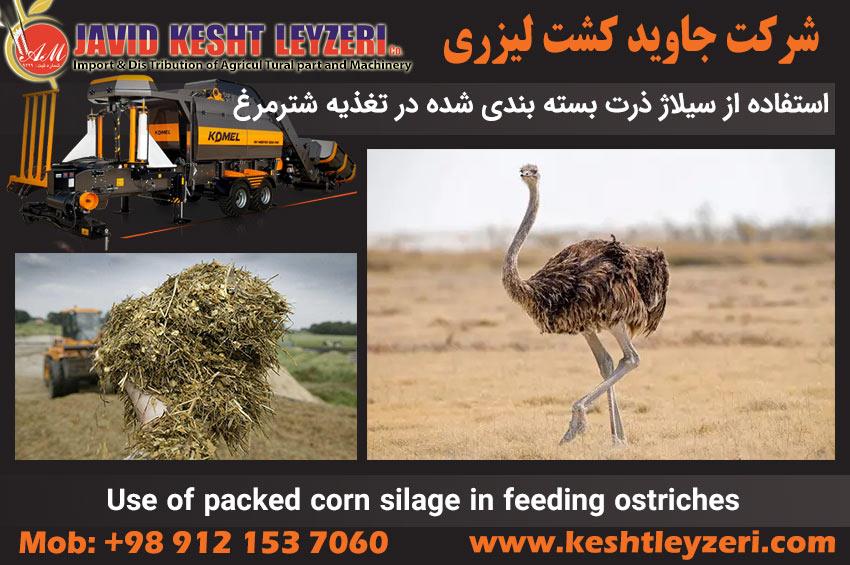
Use of packed corn silage in feeding ostriches
javid keshtleyzeri Co.ltd
Packaged silage can have variable nutrients depending on what kind of edible material it is made from, but what is used the most in Iran is corn silage.
This food item has a lot of energy that can replace two basic parts in the ostrich diet, i.e. it can play the role of providing dietary fiber, which is a good substitute for hay, and providing energy, which can be a good substitute for grains in the diet, especially At a time when the price of grains increases, which can increase economic efficiency and play a significant role in reducing feed costs. Another effect of silage is increasing the palatability of the ration.
A review of researches on the use of silage in feeding ostriches
In a study conducted in Zimbabwe in 2009 by Dube et al. 60 pieces of 5-month-old birds with an average weight of 55 kg were evaluated in two groups of 30 pieces.
The first group was fed only with growth ration without silage and the second group was fed with 1 ratio of growth ration and 2 parts of silage.
The parameters that were evaluated included: feed consumption, growth rate and conversion rate.
The duration of this experiment was 70 days and the birds were weighed every 14 days.
From the results of this experiment, it was found that there is no significant difference between these two rations in the investigated parameters, but in general, the results obtained from the group that received the ration with silage were higher than the group fed with the normal ration.
In another experiment conducted by Samuel Lozano et al. (2008), the effect of corn silage on the digestibility of ostrich diets was investigated. In this study, 4 different diets with different percentages of silage were investigated (diet A: no silage, diet B: 10% silage, diet C: 20% silage and diet D: 30% silage) and the nutrients in all these diets were uniform. Was considered. In total, there was no significant difference between different rations in the amount of feed consumption, weight gain or conversion factor. However, the presence of corn silage in the rations showed a better performance in the use of protein and fibrous parts of the feed. The cost of ration also decreased with the increase in the level of corn silage in the ration. The results of this experiment showed that the use of corn silage in the diet of ostriches can increase technical and economic efficiency.
In another experiment conducted by Bovera et al. (2001), the digestibility of corn silage was investigated in laboratory conditions. In this study, alfalfa digestibility was also measured and according to the results of this experiment, the digestibility of corn silage was estimated at 63.82% and alfalfa at 55.5%.
Things that are important in using silage in feeding ostriches:
What should be considered in the use of silage is the quality of the silage, which should include moisture content and the level of fermentable carbohydrates.
The amount of dry matter of corn silage is usually considered to be 33%, but this amount varies between 25 and 35%. Unfortunately, in Iran, due to the lack of proper knowledge of how to make silage, this amount of dry matter is not obtained in silage, which also reduces other nutrients (in Iran, about 20% of dry matter is obtained in ground silos). The problem here is that as silage moisture increases, livestock must consume more silage on a dry matter basis to achieve the same level of nutrients compared to silage with lower moisture content. This itself is a reason for the limitation in using silage in ostriches because the volume of the ostrich's digestive system allows the use of feed to a certain extent. We make this clear with a simple example:
If you consider two rations, in both of which 20% corn silage is used, in one corn silage with 33% dry matter and in the other corn silage with 27% dry matter is used, now to achieve the same availability of Nutrients should be used by the ostrich as follows.
Diet, type of food, dry matter (percent), percentage in the diet in terms of as fed, percentage in the diet in terms of 100% of dry matter
1 corn silage 33 20 6/60
Concentrate 90 80 8/88
2 corn silage 27 20 74
Concentrate 90 80 8/88
This table shows that in one kilogram of ration, 200 grams of corn silage with 33% dry matter should be used in order to achieve the same nutrient in terms of dry matter, 606 grams of silage should be used in the diet, but if the moisture content of corn silage increases and its dry matter If it reaches 27%, 740 grams of silage should be used to replace the same nutrient, that is, a 6% decrease in silage dry matter causes a 13.4% increase in silage consumption. Now, if we consider that an ostrich needs 2 kg of feed per day, 1212 grams of silage and 1776 grams of concentrate should be used for the first ration, and 1480 grams of silage and 1776 grams of concentrate should be used for the second ration (the dry matter of the concentrate is considered 90% has been). If the quality of the silage is lower, which in turn reduces the dry matter, it causes a restriction in the ostrich to use the ration because the capacity of the ostrich's digestive system is limited.
The amount and type of fermentable carbohydrates in silage is very important. This determines to what extent the pH of the silage decreases during the fermentation period and what type of volatile fatty acid is dominant in the silage. As much as possible, silage pH should be reduced to 4, because under these conditions, harmful bacteria such as Clostridium and Enterobacter cannot grow and the population of lactic acid-producing bacteria reaches its maximum. Increased levels of clostridium increase digestive problems in ostriches.
Another problem that exists in the use of silos, which can be seen especially in ground silos






